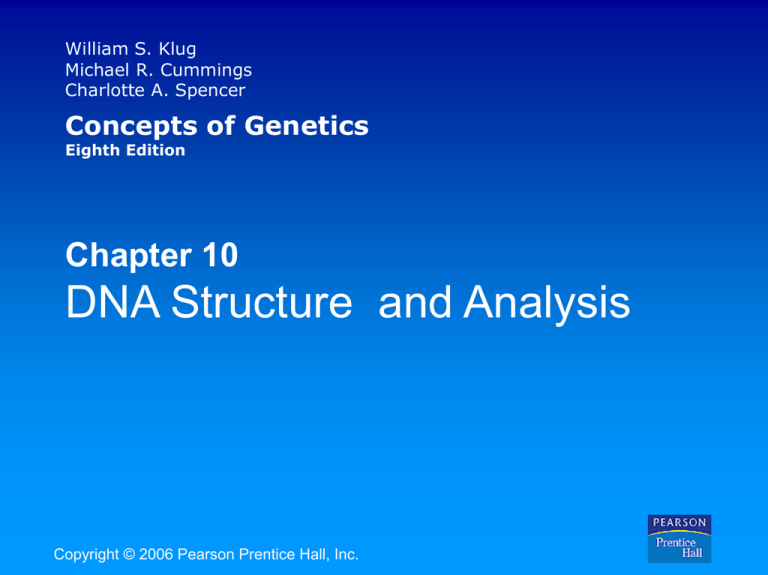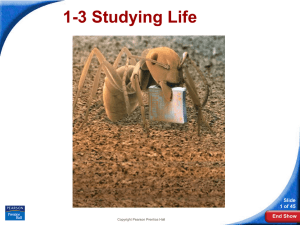
William S. Klug
Michael R. Cummings
Charlotte A. Spencer
Concepts of Genetics
Eighth Edition
Chapter 10
DNA Structure and Analysis
Copyright © 2006 Pearson Prentice Hall, Inc.
The Genetic Material Must
Exhibit Four Characteristics
• Replication
• Storage of information
• Expressison of information
• Variation by mutation
Figure 10-1
Copyright © 2006 Pearson Prentice Hall, Inc.
Until 1944, Observations
Favored Protein as the
Genetic Material
Figure 10-2
Copyright © 2006 Pearson Prentice Hall, Inc.
Evidence Favoring DNA as
the Genetic Material Was
First Obtained during the
Study of Bacteria and
Bacteriophages
Transformation: Early Studies
Figure 10-3
Copyright © 2006 Pearson Prentice Hall, Inc.
Table 10-1
Copyright © 2006 Pearson Prentice Hall, Inc.
Evidence Favoring DNA as
the Genetic Material Was
First Obtained during the
Study of Bacteria and
Bacteriophages
Transformation: The Avery, MacLeod,
and McCarty Experiment
Figure 10-4
Copyright © 2006 Pearson Prentice Hall, Inc.
Evidence Favoring DNA as
the Genetic Material Was
First Obtained during the
Study of Bacteria and
Bacteriophages
The Hershey–Chase Experiment
Figure 10-5
Copyright © 2006 Pearson Prentice Hall, Inc.
Figure 10-6
Copyright © 2006 Pearson Prentice Hall, Inc.
Evidence Favoring DNA as
the Genetic Material Was
First Obtained during the
Study of Bacteria and
Bacteriophages
Transfection Experiments
Indirect and Direct Evidence
Supports the Concept that
DNA Is the Genetic Material
in Eukaryotes
Indirect Evidence: Distribution of DNA
Indirect Evidence: Mutagenesis
Table 10-2
Copyright © 2006 Pearson Prentice Hall, Inc.
Figure 10-7
Copyright © 2006 Pearson Prentice Hall, Inc.
Indirect and Direct Evidence
Supports the Concept that
DNA Is the Genetic Material
in Eukaryotes
Direct Evidence: Recombinant DNA
Studies
RNA Serves as the Genetic
Material in Some Viruses
Knowledge of Nucleic Acid
Chemistry Is Essential to the
Understanding of DNA
Structure
Nucleotides: Building Blocks of Nucleic
Acids
Figure 10-9a
Copyright © 2006 Pearson Prentice Hall, Inc.
Figure 10-9b
Copyright © 2006 Pearson Prentice Hall, Inc.
Figure 10-10
Copyright © 2006 Pearson Prentice Hall, Inc.
Knowledge of Nucleic Acid
Chemistry Is Essential to the
Understanding of DNA
Structure
Nucleoside Diphosphates and
Triphosphates
(dATP)
Figure 10-11
Copyright © 2006 Pearson Prentice Hall, Inc.
Knowledge of Nucleic Acid
Chemistry Is Essential to the
Understanding of DNA
Structure
Polynucleotides
Figure 10-12
Copyright © 2006 Pearson Prentice Hall, Inc.
Figure 10-12a
Copyright © 2006 Pearson Prentice Hall, Inc.
Figure 10-12b
Copyright © 2006 Pearson Prentice Hall, Inc.
The Structure of DNA Holds
the Key to Understanding
Its Function
Base Composition Studies
X-Ray Diffraction Analysis
Table 10-3
Copyright © 2006 Pearson Prentice Hall, Inc.
Figure 10-13
Copyright © 2006 Pearson Prentice Hall, Inc.
The Structure of DNA Holds
the Key to Understanding
Its Function
The Watson–Crick Model
Figure 10-14
Copyright © 2006 Pearson Prentice Hall, Inc.
Figure 10-14a
Copyright © 2006 Pearson Prentice Hall, Inc.
Figure 10-14b
Copyright © 2006 Pearson Prentice Hall, Inc.
Figure 10-14c
Copyright © 2006 Pearson Prentice Hall, Inc.
Figure 10-15
Copyright © 2006 Pearson Prentice Hall, Inc.
Figure 10-16
Copyright © 2006 Pearson Prentice Hall, Inc.
Alternative Forms of DNA
Exist
Figure 10-17
Copyright © 2006 Pearson Prentice Hall, Inc.
Figure 10-17a
Copyright © 2006 Pearson Prentice Hall, Inc.
Figure 10-17b
Copyright © 2006 Pearson Prentice Hall, Inc.
The Structure of RNA Is
Chemically Similar to DNA,
but Single Stranded
Many Analytical
Techniques Have Been
Useful during the
Investigation of DNA and
RNA
Absorption of Ultraviolet Light (UV)
Sedimentation Behavior
Figure 10-18
Copyright © 2006 Pearson Prentice Hall, Inc.
Figure 10-19
Copyright © 2006 Pearson Prentice Hall, Inc.
Many Analytical
Techniques Have Been
Useful during the
Investigation of DNA and
RNA
Denaturation and Renaturation of
Nucleic Acids
Figure 10-20
Copyright © 2006 Pearson Prentice Hall, Inc.
Many Analytical
Techniques Have Been
Useful during the
Investigation of DNA and
RNA
Molecular Hybridization
Figure 10-21
Copyright © 2006 Pearson Prentice Hall, Inc.
Many Analytical Techniques
Have Been Useful during
the Investigation of DNA
and RNA
Fluorescent in situ Hybridization
(FISH)
Figure 10-22
Copyright © 2006 Pearson Prentice Hall, Inc.
Many Analytical Techniques
Have Been Useful during
the Investigation of DNA
and RNA
Reassociation Kinetics and Repetitive
DNA
C/C0 = 1/1+kC0t
Figure 10-23
Copyright © 2006 Pearson Prentice Hall, Inc.
Figure 10-24
Copyright © 2006 Pearson Prentice Hall, Inc.
Figure 10-25
Copyright © 2006 Pearson Prentice Hall, Inc.
Figure 10-26
Copyright © 2006 Pearson Prentice Hall, Inc.
Many Analytical
Techniques Have Been
Useful during the
Investigation of DNA and
RNA
Electrophoresis of Nucleic Acids
Figure 10-27
Copyright © 2006 Pearson Prentice Hall, Inc.






